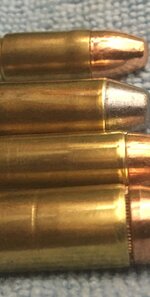Member 5605
- Messages
- 11,671
- Reactions
- 23,700
No.I'm gonna have to chrono some of these as I expect that this will add to the overall pressure yes/no?
Measure bullet (.355) then measure case inside diameter. Quickly you will find that the ID is smaller than the OD of the bullet. If you want it gone get a factory sizing die, that will make the exterior uniform. Nothing to worry about. It's not the dies or the bullet, it's the different types of brass. Heck my .38specials will do it and some 357 Mag, almost all of my .40's do it because I'm loading cast in them.
Last Edited:












